Intel’s Sandy Bridge i7-2820QM: Upheaval in the Mobile Landscape
by Jarred Walton on January 3, 2011 12:00 AM EST- Posted in
- Laptops
- Intel
- Sandy Bridge
- Compal
Extended Compatibility and Performance Results – Medium Detail
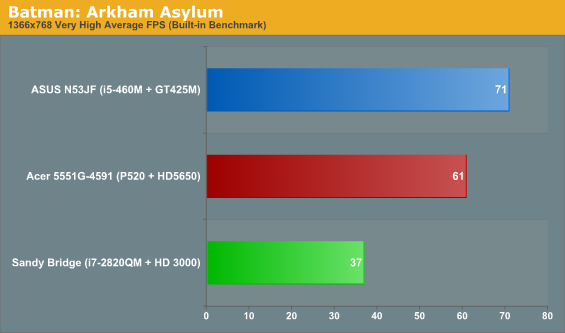

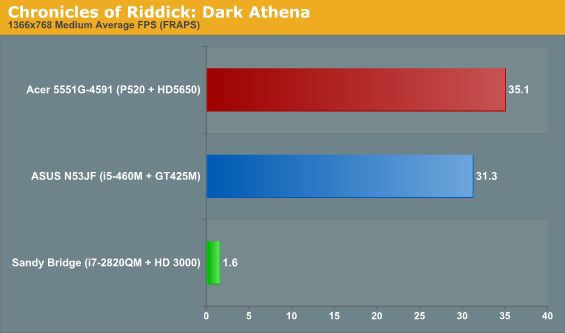
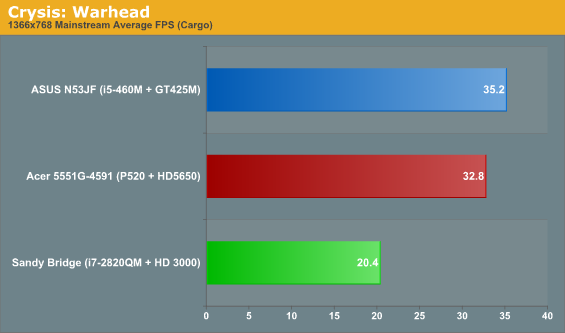
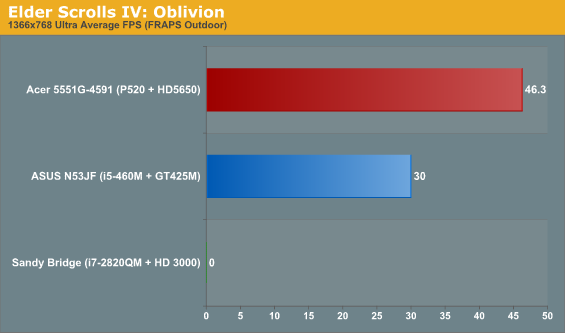
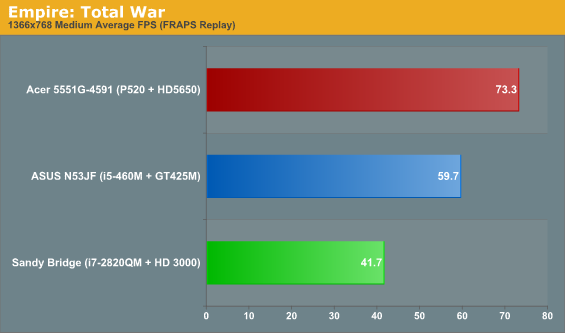
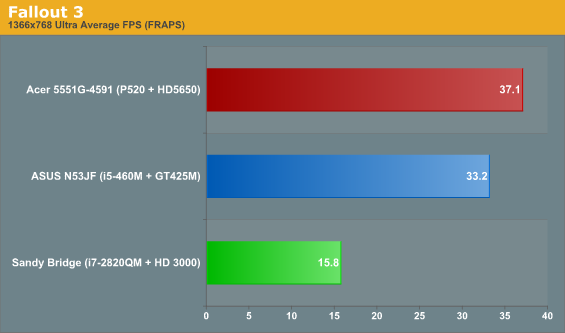

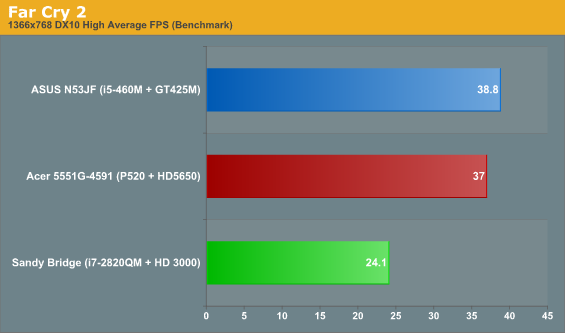
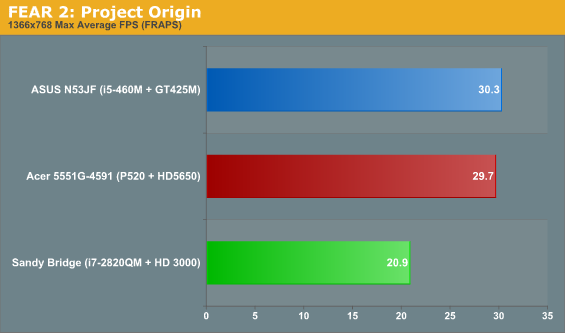
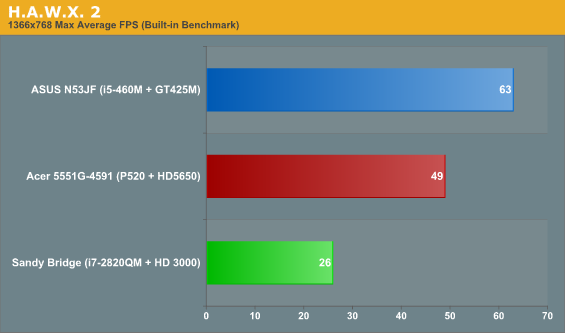
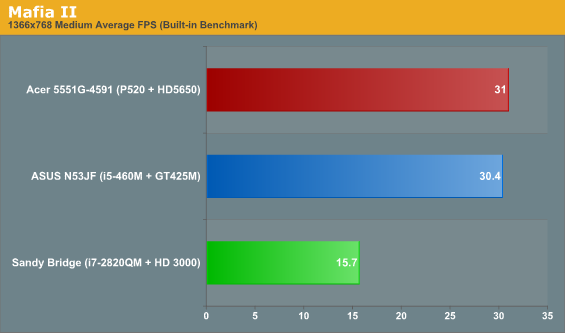

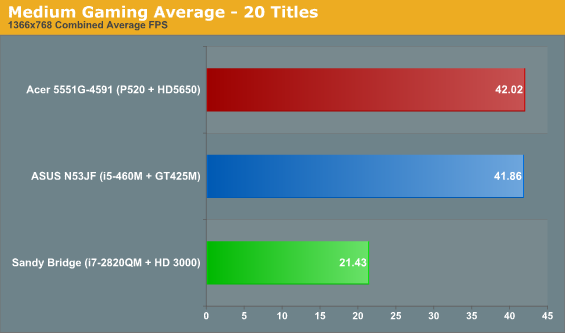
Bumping quality settings up to Medium puts the screws to the HD 3000, dropping nearly every test game below 30FPS. Besides Mass Effect 2 and STALKER (which we mentioned on the previous page), only Empire: Total War breaks the 30FPS mark, and it’s not even a clear victory there. Yes, Intel can run Medium detail at 42FPS, but the game prevents us from selecting the “High” defaults, which is where we would have preferred to test. (This is possibly another case of blacklisting, although not as severe as Fallout 3.)
At our Medium settings, the discrete GPUs easily pull away from Sandy Bridge, with both the Acer 5551G and ASUS N53JF nearly doubling (95-96% faster on average) the HD 3000. Rendering quality also gets worse in HAWX 2, with the entire skybox missing once detail levels are increase, so you get a black sky. (It’s still better than the horribly corrupted rendering that Arrandale’s IGP managed at lower settings.)
Ultimately, Sandy Bridge’s IGP is far more capable than many would have expected. Sure, it doesn’t even try to support DX11 or OpenCL, but at least for gaming DX11 is typically too much for even midrange GPUs. Intel uses 114 million transistors in Sandy Bridge on the graphics, which is quite small considering transistor counts on other GPUs. The HD 5470 for example—a chip that is frequently surpassed by HD 3000—has an estimated count of 242 million transistors.
This is where Intel’s manufacturing prowess comes into play, as SNB uses a refined 32nm process that allows Intel to push clock speeds far higher than other competing offerings. What’s more, late 2011 should bring the follow-up Ivy Bridge processor, which shrinks the process even further to 22nm. At that node, Intel could potentially double the number of EUs (Execution Units) and further increase clocks. If Intel puts the requisite effort into improving driver compatibility and adds DX11 support, and if rumors of high-bandwidth stacked memory prove true, next year we could see integrated graphics reach the point where they match HD 5650/GT 425M, effectively killing off anything less than the upper-midrange and lower-high-end discrete GPUs.










66 Comments
View All Comments
tipoo - Monday, January 3, 2011 - link
Sorry if I missed this somewhere in the review, but does the graphics component support OpenCL?RyuDeshi - Monday, January 3, 2011 - link
Second to last paragraph on the "Extended compatibility and performance results:""Ultimately, Sandy Bridge’s IGP is far more capable than many would have expected. Sure, it doesn’t even try to support DX11 or OpenCL, but at least for gaming DX11 is typically too much for even midrange GPUs."
CharonPDX - Monday, January 3, 2011 - link
An Intel rep has said that Sandy Bridge will support OpenCL. (http://news.cnet.com/8301-13924_3-20024079-64.html ) The trick is that it may be a combo CPU+GPU to do it. So it may not be what you are thinking by OpenCL being solely GPU, but OpenCL code should be able to run.And in the end, what does it matter, really, as long as it runs? As the desktop Sandy Bridge review points out, video encoding is just as fast using solely the x86 codepaths as using nVidia's CUDA or ATI's Stream.
Voldenuit - Monday, January 3, 2011 - link
OpenCL was designed from the outset to run on heterogenous resources, including CPU.So intel claiming that they "support" OpenCL is nothing special - they just needed the right drivers/API.
However, don't expect OpenCL code running solely on the CPU (my guess as to how SB will handle it) to be any faster than the x86 codepath running on the same CPU.
Checkbox feature.
jameskatt - Monday, January 3, 2011 - link
What Intel wants to do is to have the CPU run OpenCL code.This totally defeats the purpose of OpenCL.
OpenCL is suppose to allow both the GPU and the CPU to run code simultaneously. This is to allow significant acceleration in running OpenCL code compared to using just the CPU.
Sure. OpenCL code will run. But it will run MORE SLOWLY than with a discrete GPU. And the 16 GPUs in Sandy Bridge will be wasted.
Intel's Sandy Bridge has non-programmable GPUs. This is a serious limitation and deal killer when it comes to running OpenCL code.
I expect Apple to continue use nVidia's or AMD's discrete GPUs with the MacBooks and Mac Book Pros.
This is very disappointing. It shows that Intel still doesn't have the talent to produce decent GPUs.
PlasmaBomb - Monday, January 3, 2011 - link
*cough* I think you mean 12 EU *cough*
Guspaz - Monday, January 3, 2011 - link
<i>What Intel wants to do is to have the CPU run OpenCL code.This totally defeats the purpose of OpenCL.
OpenCL is suppose to allow both the GPU and the CPU to run code simultaneously. This is to allow significant acceleration in running OpenCL code compared to using just the CPU.</i>
No, this is the *primary* purpose of OpenCL. The goal of OpenCL is not to "allow the GPU and CPU to run code simultaneously", but to provide a single unified code path that can be used with any hardware, be it CPU or GPU. There are/were already code paths specific to each vendor/type (CUDA for nVIDIA GPUs, Stream for AMD/ATI GPUs, x86 for Intel/AMD CPUs). The problem is that fully supporting all three platforms requires three separate code paths.
OpenCL unifies this, and allows a single codepath to be used regardless of the GPU's type or existence. You've completely misunderstood the purpose of OpenCL.
Wiggy McShades - Tuesday, January 4, 2011 - link
You need to ask what applications on a desktop actually use OpenCL in a meaningful way? Intel added hardware for media transcoding, which makes transcoding on something besides the cpu useless and that was roughly all openCL can be used for on the desktop, laptop, or cellphone.OpenCL is for vector calculations, AVX is for vector calculations. All four cores running AVX instructions would just be a faster choice than OpenCL on a low end gpu. Intel most likely could get sandybridge's gpu running OpenCL, but it would be pointless. OpenCL just is not a desktop feature.
strikeback03 - Wednesday, January 5, 2011 - link
Given how much money they have, I doubt Intel is lacking the "talent" to do anything they want. OpenCL execution on the GPU portion of the SNB chips was probably just not that big a deal to them, and given the number of other things (such as speed and battery life) SNB brings to the table they probably won't have trouble selling lots of these to the average consumer.8steve8 - Monday, January 3, 2011 - link
which mobile cpus on pg1 support TXT or VT-d or AES-NI or VT-x or Quick Sync?